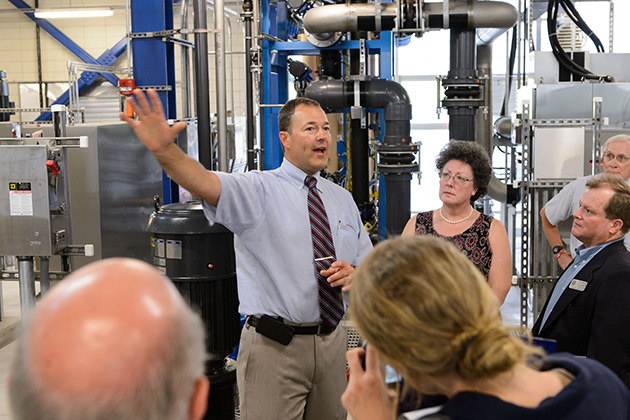
A facility that lets the University of Connecticut conserve hundreds of thousands of gallons of drinking water every day is now fully operational, a cornerstone of UConn’s environmental protection efforts and the culmination of years of planning.
UConn’s new water reclamation facility came online in stages during late spring and early summer. It’s now providing up to 500,000 gallons of treated wastewater on high-demand days to help run the Storrs campus power plant, which previously used potable water.
Officials from UConn, the Connecticut Department of Energy & Environmental Protection, and other agencies gathered Wednesday at the facility to mark its completion and learn about the technology used to clean the wastewater through microfiltration, reverse osmosis, and ultraviolet disinfection.
The $25 million facility can process up to 1 million gallons of water daily and is the first of its kind in Connecticut. It currently processes about 230,000 gallons on an average day and up to 500,000 gallons on peak days – such as during the recent heat wave – when the power plant faces high demand for electricity and air conditioning.


“UConn is a leader in efficiency, conservation, and sustainability, and the new water reclamation facility is the latest proof of its commitment to leading-edge environmental practices,” says DEEP Commissioner Daniel Esty, one of the guests and speakers at Wednesday’s event.
“By substituting processed wastewater for high-quality drinking water for various functions, the University is helping to conserve valuable natural resources and is setting an example that will inspire students and serve as a model for others to follow,” he adds.
The power plant is currently the single largest user of potable water at UConn, requiring as much as 450,000 gallons of water on a sweltering summer day.
Every gallon of wastewater that is “reclaimed” at the new facility avoids the need to use drinking water to cool the power plant’s fan turbines, helping free up the campus supply of potable water for other uses.
By substituting processed wastewater for high-quality drinking water for various functions, the University is helping to conserve valuable natural resources and is setting an example.
Once the treated wastewater is used at the power plant, it is sent back to the reclamation facility for re-treatment, significantly reducing the University’s effluent discharge.
“This project illustrates UConn’s strong commitment to the environment and is another way in which the University translates its policies into practice,” says UConn President Susan Herbst. “It’s a tangible example of our environmental stewardship, and one of the reasons UConn is consistently included in the ranks of the nation’s most ‘green’ universities.”
The facility will also serve as a living laboratory for educating students about green technologies and environmentally sustainable operations and practices. In the future, reclaimed water from the facility may also be used for irrigation purposes – for use on athletic and recreational fields, for example.
Several sustainable design measures were incorporated into the building itself, including features to recover heat from exhaust air, generate power from photovoltaic cells, and capture rainfall runoff from the roof so it can be treated and used at the power plant.
With the only public water supply system within a five-mile radius, the University is responsible for providing water not only to meet the needs of the Storrs campus, but also for more than 100 users across parts of Mansfield, including the Town Hall, E.O. Smith High School, and the emerging downtown Storrs Center.
UConn’s water is drawn from groundwater wells near the Fenton and Willimantic rivers, consistent with state permits that regulate how much water can be withdrawn.
Even before the water reclamation plant came online, UConn’s conservation efforts resulted in a significant decrease in potable water use between 2005 (about 1.5 million gallons daily) and last year (about 1.26 million gallons a day) – despite having a larger population and more buildings to serve. The reclamation plant is expected to significantly add to those conservation efforts.
Other UConn conservation efforts include ‘green’ building design practices; the widespread use of drought-tolerant plants in areas that collect runoff and roof drainage; the addition of low-flow fixtures in campus buildings; eliminating trays in dining halls to avoid the need to wash them; outreach efforts to and by students to spread the conservation ethos; and other measures.


